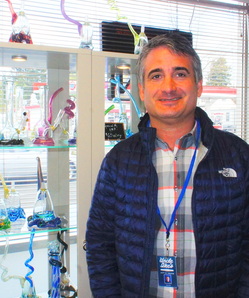 Six or seven years ago I wrote a snarky piece about a guy named Ian Eisenberg and a business venture called Zevia. Eisenberg was an internet entrepreneur (Blue Frog Mobile) but Zevia was a dietary supplement (or was it a soda?) that's since been sold to an outfit in Los Angeles. Meantime, the health & wellness game has proven a cushy spot for Eisenberg: he's positioned himself, at the intersection of 23rd Avenue and E. Union Street, as the Poobah of Pot and Maharajah of Marijuana.
Six or seven years ago I wrote a snarky piece about a guy named Ian Eisenberg and a business venture called Zevia. Eisenberg was an internet entrepreneur (Blue Frog Mobile) but Zevia was a dietary supplement (or was it a soda?) that's since been sold to an outfit in Los Angeles. Meantime, the health & wellness game has proven a cushy spot for Eisenberg: he's positioned himself, at the intersection of 23rd Avenue and E. Union Street, as the Poobah of Pot and Maharajah of Marijuana.
The shop is called Uncle Ike's, an emporium of legal weed in all its forms. Cash only. Beefy security guards checking ID. A completely separate building for accessories. Skeptical neighbors. Intense scrutiny from the state liquor board.
"I'm not selling pot," Eisenberg told me, "I'm in the regulatory compliance business."
But if Uncle Ike's is the future of cannabis, some of the old myths die hard, most notably the code word under which marijuana has operated for decades: 420.
The story goes that a group of kids calling themselves the Waldos, students at San Raphael High School, would get together at 4:20 in the afternoon to smoke. Not true, says Alex Mayer, former publisher of the Belltown Messenger and self-described "pot shop writer." Mayer says that the marijuana community's unofficial house magazine, High Times, came up with the story and promoted "420" as a sort of secret symbol, like a fish for early Christians, even though there was no evidence that it was true.
Meantime, another group calling itself the Waldos came up with its own mythology. Eventually, High Times launched its own domain, www.420.com. The Waldos countered with 420Waldos.com.
Mayer's 2,500-word article (on the Uncle Ike's website) puts little credence in either claim and concludes that 420, at any rate, is outdated. "Marijuana users these days don't need code words, they just need cash" to buy legal weed.
UPDATE May 11th: Weed may be legal, but what are those protestors doing outside Uncle Ike's? Read the answer here.
Leave a comment